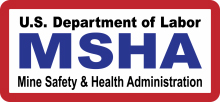MSHA to place emphasis on three safety standards
While we wait for further signs of what changes the Trump administration may bring to mine safety and health enforcement, we heard recently from the Mine Safety & Health Administration (MSHA) at an industry meeting that there are three categories of safety standards the agency will be emphasizing this year.
Those standards concern lockout/tagout, seat belts and fall protection.
 When it comes right down to it, each of these standards focuses on rather simple steps that can make the critical difference in safety: installing a lock and tag on equipment to undergo repair, fastening a seat belt, and selecting and wearing appropriate fall protection.
When it comes right down to it, each of these standards focuses on rather simple steps that can make the critical difference in safety: installing a lock and tag on equipment to undergo repair, fastening a seat belt, and selecting and wearing appropriate fall protection.
These are not difficult things to do. They do not require much more than a moment’s attention to that protective step in the process of getting the job done. They should be routine, but the fact that they become routine can be the source of the problem.
In the rush to get a job done, we sometimes take shortcuts. We become so accustomed to doing a routine task that we skip what might seem like an unimportant step. We might say to ourselves, “It will just take a moment to finish this job, so the risk is low.”
Safety and health protective measures must never be considered “just something extra” that can be ignored or an unnecessary hindrance toward getting the job done quickly. Safety procedures must be viewed as an integral part of the job. Training, workplace observations, coaching and discipline all make important contributions in emphasizing this.
In industry meetings a little over a year ago, MSHA communicated a similar message about two other standards that the agency would be focused on in the coming year. Those standards were task training and workplace examinations.
MSHA has been true to its word on that message. We have seen increased citations and walk-and-talks emphasizing the agency’s view that task training and workplace examinations reduce accidents and injuries. As is well known, the agency also issued a new workplace exam rule in record time, adding requirements that stand to significantly impact mine operators. There is every reason to believe MSHA will continue its heightened enforcement on task training and workplace examinations, adding to it the three standards in the latest announcements to industry. Here’s a closer look at the three things MSHA says it will emphasize this year:
Lockout/tagout
For work on electrically powered equipment, 30 C.F.R. 56/57.12016 includes the following requirements:
■ De-energize equipment before mechanical work is to be done.
■ Lock out power switches or apply other measures to prevent energization without knowledge of the individuals doing the work.
■ Post warning notices at the power switch signed by the individuals doing the work (Note: a tag on the lock is acceptable).
■ Locks may only be removed by the people doing the work.
For work on power circuits, 30 C.F.R. 56/57.12017 requires the following:
■ De-energize circuits before work is done, unless hot-line tools are used.
■ The people doing the work must post warning signs.
■ Lock out switches or apply other protective measures to prevent energization occurring without knowledge of those doing the work.
■ Locks may only be removed by the people doing the work or by other authorized personnel.
Although not required in the standards, MSHA also recommends adding “tryout” to the lockout procedure. This last step is to confirm the power is off.
Seat belts
Seat belts are required to be worn in haulage trucks (30 C.F.R. 56/57.14131) and in various other types of mobile equipment, such as graders, various types of tractors and skid-steer loaders (30 C.F.R. 56/57.14130).
MSHA’s safety alert on seat belt use on mobile equipment describes engineering and administrative controls to promote seat belt use, including interlocks, extra training, warning lights and alarms, and supervisory oversight and feedback. These things are recommended but not required by law.
Fall protection
Safety belts and lines must be worn and proper tie-off used to protect people where there is a danger of falling (56/57.15005).
MSHA has clarified through policy guidance that fall protection will generally be required where the potential falling distance is 6 ft. or more.
William Doran (william.doran@ogletree.com) and Margo Lopez (margaret.lopez@ogletree.com) are with the national labor, employment and safety law firm Ogletree Deakins.









